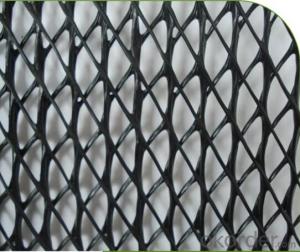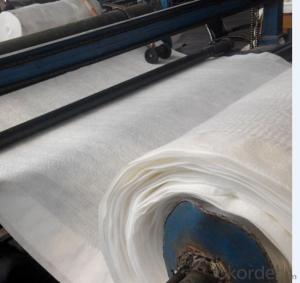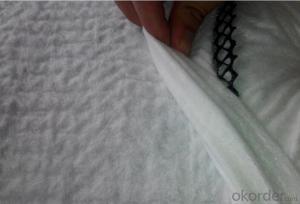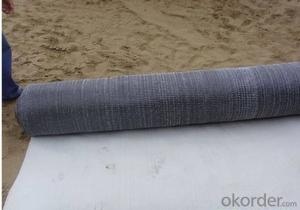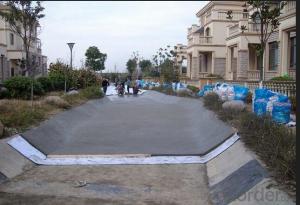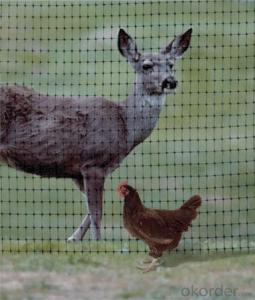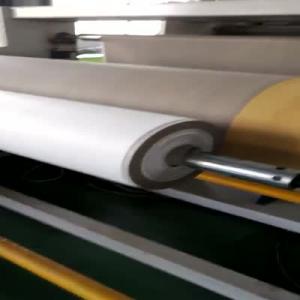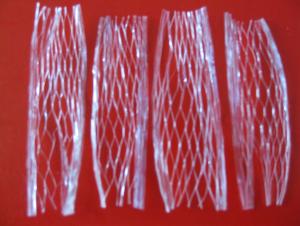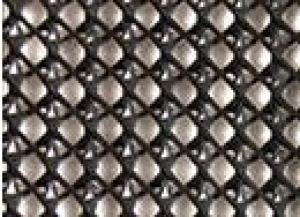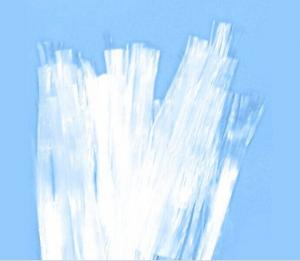HDPE Trainage Geonet /Geocomposites/Tri-dimension Drainage Composites
- Loading Port:
- Qingdao
- Payment Terms:
- TT or LC
- Min Order Qty:
- 2000 m²
- Supply Capability:
- 200000 m²/month
OKorder Service Pledge
OKorder Financial Service
You Might Also Like
Description:
Tri-dimension composite genet for drainage is a new type of geosynthetics.
Its made of atri-dimension geonet coated with geotextile on both sides. Network core consists of a tri-dimension
thick vertical rib, and a rip on top and bottom .
It can drain underground water quickly, also there is a protection system,which can block the capillary water under high load. At the same time, it can also reinforce and isolate of foundation.
Specifications:
core thickness: 5 mm - 8 mm
unit weight: 750g/m2-1500g/m2
width: 2 - 4m,
composite geotextile: short fiber needle punched geotextile,filament spunbonded needle punched geotextile,the length at request .
Typical Application:
Landfill drainage; roadbed and road drainagel; railway drainage, tunnel drainage, undergroud structure drainage, the retaining back wall drainage, gardens and sports grouds drainage
Features:
Excellent drainage function, can bear long time hige press load
High tensile and shear strength
Reduce the rate geotextile embedding into the core of geonet, can protect long time stable water conductivity
Tri-dimension composite geonet for drainage can bear more than kpa compression load
Its anti-compression capacity is much larger than common geonet for drainage.
Specifications:
Drainage netwrok core | units | Specification | |||
Unit weight | g/m2 | 750 | 1000 | 1300 | 1600 |
Thickness OV=20kpa | mm | 5.0 | 6.0 | 7.0 | 7.6 |
Hydraulic conductivity | m/s | K x 10 -4 | K x 10 -4 | K x 10 -3 | K x 10 -3 |
Elongation | % | <50< span=""> | <50< span=""> | <50< span=""> | <50< span=""> |
Tensile strength ( core network) | KN/m | 8 | 10 | 12 | 14 |
Geotextile | g/m2 | 200-200 | 200-200 | 200-200 | 200-200 |
Properties:
Tri-dimension composite geonet for drainage is made of a unique tri-dimension geonet coated with geotextile
on both sides.
It has the property of geotextile(filtration) and geonet (drainage and protection) and provide a function system of“filtration-drainage-protection”.
The tri-dimension structure can bear higher load in construction and remain certain thickness,strength and
excellent in water conductivity.
FAQ
1. Which payment do you accept?
For you convinience,our payment can be L/C,TT
2. Is free sample available?
We can supply free samples if you need.
3. How about your quality?
We have strict quality control system, we make testing on incoming raw material and finished products. Your third party testing is also welcomed. With high quality, our products are used on government projects at home and abroad. Our product quality is accepted by clients from all over the world
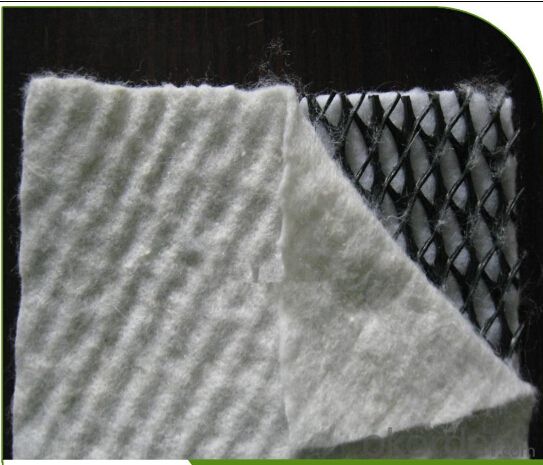
- Q:What are the different surface patterns available in earthwork products?
- There are various surface patterns available in earthwork products, including smooth, textured, stamped, and exposed aggregate finishes. Smooth surfaces provide a sleek and polished look, while textured patterns offer a more rugged and natural appearance. Stamped patterns allow for intricate designs and imitate the look of various materials like brick or stone. Exposed aggregate surfaces showcase the natural beauty of the aggregates used in the concrete mix. These different surface patterns provide options for customization and can enhance the aesthetic appeal of earthwork products.
- Q:What is the purpose of using geotextile tubes in shoreline stabilization projects?
- The purpose of using geotextile tubes in shoreline stabilization projects is to provide effective erosion control and protect coastal areas from the damaging effects of waves, currents, and storms. These tubes act as a barrier, trapping sediment and preventing it from being washed away, while also promoting the growth of vegetation. They offer a cost-effective and environmentally friendly solution to maintain and restore the natural balance of coastal ecosystems.
- Q:How do earthwork products contribute to erosion control on hillsides?
- Earthwork products, such as retaining walls, terraces, and erosion control blankets, play a crucial role in controlling erosion on hillsides. Retaining walls help to stabilize the soil and prevent it from washing away during heavy rainfall or runoff. Terraces create level areas on slopes, reducing the speed of water flow and allowing it to infiltrate into the soil, thus minimizing erosion. Erosion control blankets, made of biodegradable materials, provide a protective layer over the soil, preventing it from being displaced by wind or water. Overall, these earthwork products effectively contribute to erosion control on hillsides by stabilizing the soil, reducing water flow, and protecting it from external forces.
- Q:What are the different colors available for earthwork products?
- The different colors available for earthwork products can vary depending on the specific material being used. Some common colors include natural earth tones such as browns, grays, and tans. However, certain products may also be available in a wider range of colors, including reds, greens, blues, and even custom colors. It ultimately depends on the manufacturer and the specific requirements of the project.
- Q:What are the different load capacities available for earthwork products?
- The load capacities available for earthwork products can vary widely depending on the specific product and its intended use. Some common load capacities include 10 tons, 20 tons, 30 tons, and even higher capacities for specialized applications. It is important to carefully consider the load capacity requirement for each specific project to ensure that the earthwork products can safely support the intended loads.
- Q:Can geosynthetics be used for lining canals and reservoirs?
- Yes, geosynthetics can be used for lining canals and reservoirs. Geosynthetics such as geomembranes and geotextiles are commonly used to provide a protective barrier and prevent leakage of water in these applications. They offer various advantages such as durability, flexibility, and resistance to chemicals, making them suitable for lining canals and reservoirs.
- Q:Are earthwork products resistant to freeze-thaw cycles?
- Yes, earthwork products are generally resistant to freeze-thaw cycles.
- Q:Can earthwork products be used for waterway management?
- Yes, earthwork products can be used for waterway management. These products, such as geomats, geotextiles, and gabions, are commonly used in waterway projects to control erosion, stabilize banks, and promote proper water flow. They provide effective solutions for sediment control, shoreline protection, and water quality improvement, making them valuable tools in waterway management.
- Q:Can earthwork products be used in slope reinforcement?
- Yes, earthwork products can be used in slope reinforcement. These products, such as geotextiles, geogrids, and erosion control blankets, are specifically designed to stabilize and reinforce slopes. They help to prevent soil erosion, improve slope stability, and provide long-term support to the slopes.
- Q:How are geosynthetic materials used in railway track stabilization?
- Geosynthetic materials are used in railway track stabilization by providing reinforcement and separation functions. They are typically placed beneath the track ballast to prevent the mixing of subgrade soil with the ballast, reducing the risk of track settlement and deformation. Additionally, geosynthetics enhance load distribution, increase the overall stability of the track, and improve the overall performance and longevity of the railway infrastructure.
1. Manufacturer Overview |
|
|---|---|
| Location | |
| Year Established | |
| Annual Output Value | |
| Main Markets | |
| Company Certifications | |
2. Manufacturer Certificates |
|
|---|---|
| a) Certification Name | |
| Range | |
| Reference | |
| Validity Period | |
3. Manufacturer Capability |
|
|---|---|
| a)Trade Capacity | |
| Nearest Port | |
| Export Percentage | |
| No.of Employees in Trade Department | |
| Language Spoken: | |
| b)Factory Information | |
| Factory Size: | |
| No. of Production Lines | |
| Contract Manufacturing | |
| Product Price Range | |
Send your message to us
HDPE Trainage Geonet /Geocomposites/Tri-dimension Drainage Composites
- Loading Port:
- Qingdao
- Payment Terms:
- TT or LC
- Min Order Qty:
- 2000 m²
- Supply Capability:
- 200000 m²/month
OKorder Service Pledge
OKorder Financial Service
Similar products
New products
Hot products
Hot Searches
Related keywords

